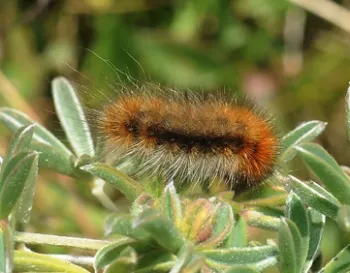Patrick Grof-Tisza Receives Marie Sklodowska-Curie Postdoctoral Fellowship

Eastern Finland University in Kuopio will be his host institution, where he will work with James Blande of the Chemical Ecology Group, Department of Environmental Sciences. Grof-Tisza met Blande while he was collaborating with Karban--his major professor and now his postdoctoral advisor--on a project involving plant-plant communication and induced resistance within sagebrush.
“The focus of my Curie postdoc will be to continue this research and to investigate community-wide effects of volatile-mediated communication,” Grof-Tisza said. “I will conduct field research in the Eastern Sierra in the spring and summer and will spend the rest of the year in Finland conducting laboratory experiments and analyzing samples collected over the field season.”
Grof-Tisza's dissertation work involved investigating how bottom-up and top-down forces regulated a focal herbivore, the Ranchman's tiger moth (Arctia virginalis; the wooly bear caterpillar that Karban has been studying since 1983) within the Bodega Marine Reserve.
“Through this work, I became interested in plant defenses, both mechanical and chemical – the primary host plant of A. virginalis contains alkaloids, which are known to deter herbivores.” He also has collaborated on several projects with his lab mate, Eric LoPresti, who studies the efficacy of sand-entrapment as a defense in sticky plants.
“I applied to the Marie Currie Fellowship to continue studying plant defenses as well as learn laboratory techniques, including those pertaining to gene expression and mass spectrometry,” said Grof-Tisza who received his bachelor's degree in molecular biology, summa cum laude, at Frostburg (Md.) State University, and then worked as a biochemist in the biotech industry prior to enrolling in graduate school at UC Davis. As a member of the Ecology Graduate Group, he received his doctorate in 2015 from UC Davis, working with advisors Richard Karban and Marcel Holyoak, a professor in the Department of Environmental Science and Policy.
“This second postdoc,” Grof-Tisza said, “will allow me to combine the ecological knowledge I have gained as a graduate student with the laboratory skills I learned earlier in my career.”
In his fellowship proposal abstract, Grof-Tisza noted “Plants have evolved an impressive defense system to combat herbivores. These defenses include morphological structures like spines and secondary metabolites that have toxic, repellent, or antinutritional effects on consumers. Many plant defenses are constitutively expressed, but some are induced in response to herbivore damage. Damaged plants emit volatile organic compounds (VOCs) into the environment that may induce defenses in adjacent, undamaged tissue or may be eavesdropped by neighboring plants, enabling them to prime their own resistance response prior to attack.”
“While once controversial, this plant-plant communication resulting in a VOC-induced phenotypic response that reduces damage from attacking herbivores has been demonstrated in over 50 species,” he wrote. “Recently, researchers have found distinguishing VOC blends among sagebrush (Artemisia tridentata) referred to as chemotypes. Field experiments demonstrated that communication between A. tridentata plants of the same chemotype resulted in less damage by herbivores compared to that between plants of different chemotypes. Chemotypes were also found to be highly heritable.”
Grof-Tisza wrote that “this is consistent with the hypothesis that volatile communication evolved as a within-plant warning mechanism due to limited vascular signaling. Because emitted volatile cues become available to potential competitors of the same or different species, selection for cues that are more private would likely be of greater benefit to the emitter. At the time of this study, only two A. tridentata chemotypes had been identified. More recent work has found an additional six chemotypes.
“Here we propose to rigorously test the ecological consequences of chemotypic variation and the processes that maintain it. Through synergistic efforts combining my expertise in field ecology and plant-insect interactions and that of the host and collaborators in ecological chemistry and molecular biology, we will forward the field of volatile-mediated plant-plant interactions.”
Grof-Tisza has published his work in a number of journals, including Ecology, Evolution and Ecology, Journal of Animal Ecology, Journal of Chemical Ecology, Ecological Entomology, Bulletin of the Ecological Society of America, Biological Conservation and Oikos. He served as an adjunct professor with the Department of Science and Engineering, American River College, Sacramento, from 2015 to 2016.
Born in Queens, N.Y., but raised in Somerset, Pa., Grof-Tisza has resided in Davis since 2007.
